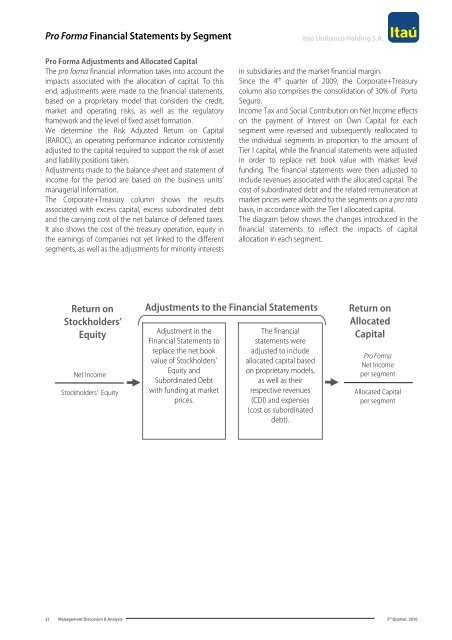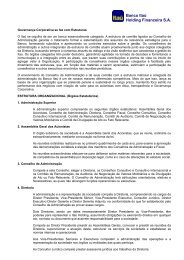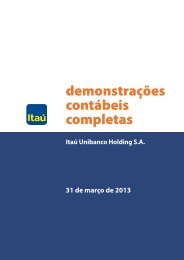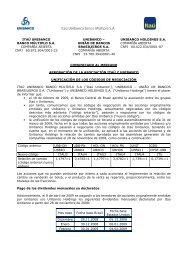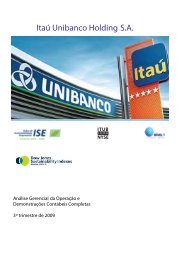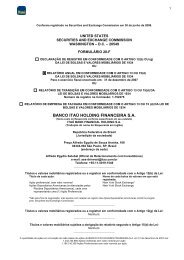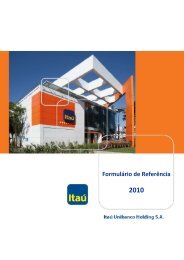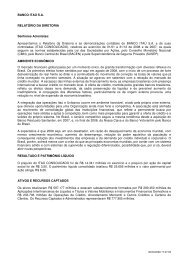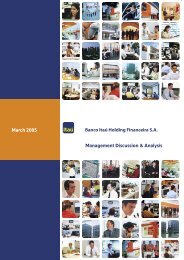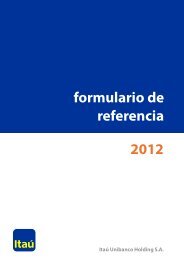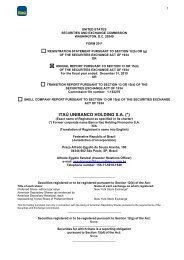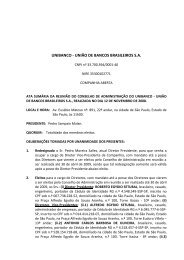MD&A and Financial Statements (PDF) - Banco Itaú
MD&A and Financial Statements (PDF) - Banco Itaú
MD&A and Financial Statements (PDF) - Banco Itaú
Create successful ePaper yourself
Turn your PDF publications into a flip-book with our unique Google optimized e-Paper software.
Pro Forma <strong>Financial</strong> <strong>Statements</strong> by Segment<br />
<strong>Itaú</strong> Unibanco Holding S.A.<br />
Pro Forma Adjustments <strong>and</strong> Allocated Capital<br />
The pro forma financial information takes into account the<br />
impacts associated with the allocation of capital. To this<br />
end, adjustments were made to the financial statements,<br />
based on a proprietary model that considers the credit,<br />
market <strong>and</strong> operating risks, as well as the regulatory<br />
framework <strong>and</strong> the level of fixed asset formation.<br />
We determine the Risk Adjusted Return on Capital<br />
(RAROC), an operating performance indicator consistently<br />
adjusted to the capital required to support the risk of asset<br />
<strong>and</strong> liability positions taken.<br />
Adjustments made to the balance sheet <strong>and</strong> statement of<br />
income for the period are based on the business units’<br />
managerial information.<br />
The Corporate+Treasury column shows the results<br />
associated with excess capital, excess subordinated debt<br />
<strong>and</strong> the carrying cost of the net balance of deferred taxes.<br />
It also shows the cost of the treasury operation, equity in<br />
the earnings of companies not yet linked to the different<br />
segments, as well as the adjustments for minority interests<br />
in subsidiaries <strong>and</strong> the market financial margin.<br />
Since the 4 th quarter of 2009, the Corporate+Treasury<br />
column also comprises the consolidation of 30% of Porto<br />
Seguro.<br />
Income Tax <strong>and</strong> Social Contribution on Net Income effects<br />
on the payment of Interest on Own Capital for each<br />
segment were reversed <strong>and</strong> subsequently reallocated to<br />
the individual segments in proportion to the amount of<br />
Tier I capital, while the financial statements were adjusted<br />
in order to replace net book value with market level<br />
funding. The financial statements were then adjusted to<br />
include revenues associated with the allocated capital. The<br />
cost of subordinated debt <strong>and</strong> the related remuneration at<br />
market prices were allocated to the segments on a pro rata<br />
basis, in accordance with the Tier I allocated capital.<br />
The diagram below shows the changes introduced in the<br />
financial statements to reflect the impacts of capital<br />
allocation in each segment.<br />
Return on<br />
Stockholders’<br />
Equity<br />
Net Income<br />
Stockholders’ Equity<br />
Adjustments to the <strong>Financial</strong> <strong>Statements</strong><br />
Adjustment in the<br />
<strong>Financial</strong> <strong>Statements</strong> to<br />
replace the net book<br />
value of Stockholders’<br />
Equity <strong>and</strong><br />
Subordinated Debt<br />
with funding at market<br />
prices.<br />
The financial<br />
statements were<br />
adjusted to include<br />
allocated capital based<br />
on proprietary models,<br />
as well as their<br />
respective revenues<br />
(CDI) <strong>and</strong> expenses<br />
(cost os subordinated<br />
debt).<br />
Return on<br />
Allocated<br />
Capital<br />
Pro Forma<br />
Net Income<br />
per segment<br />
Allocated Capital<br />
per segment<br />
31<br />
Management Discussion & Analysis 3 rd Quarter, 2010


